Flagger Struck From Behind and Killed by a Truck Intruding Into a Highway Construction Work Zone – Wisconsin
NIOSH In-house FACE Report 2000-02
Summary
On October 18, 1999, a 33-year-old female highway construction laborer (the victim), was struck and killed by a truck while flagging traffic. The victim was struck from behind by a 10-ton straight-side produce truck. Prior to the incident, the victim (Flagger 1) was on the south side of the highway facing west with her flag, preparing to stop all eastbound traffic on the highway. Another flagger (Flagger 2) was on the north side of the highway, approximately 50 feet east of the victim, and was stopping westbound traffic. Flagger 2 signaled the westbound produce truck to stop and the truck had almost come to a complete stop when a westbound tractor trailer approached at approximately 55 miles per hour and struck the produce truck in the right rear. The produce truck was struck with such force that it was momentarily airborne and the driver could not control his vehicle; the produce truck was propelled across the eastbound lane directly into the path of the victim, who was still facing west with her back to the oncoming truck. Flagger 2, on the north side of the road, was able to jump clear of the impacting trucks. He was unable to see or warn the victim. Fire rescue personnel arrived within minutes, followed by the arrival of an aeromedical helicopter. The victim was pronounced dead at the scene. The driver of the tractor trailer was also injured and transported by helicopter to a trauma center. The driver of the produce truck was uninjured.
Investigators concluded that, to help prevent similar occurrences, employers/highway construction contractors should:
- consider the use of additional warning signs and traffic control devices to supplement the minimum signs recommended by the Manual on Uniform Traffic Control Devices (MUTCD)1
- provide and require use of hand-held or other portable radio communications equipment by flaggers at all times
Additionally, NIOSH recommends that:
- state highway authorities should consider the use of law enforcement officers in cruisers at each end of large highway construction work zones and the use of radar surveillance for traffic speed control
- state highway authorities reduce speed limits in construction work zones on high-traffic-density highways to a maximum of 45 mph
Introduction
On October 18, 1999, a 33-year-old female laborer who was working for a construction contractor at a highway construction haul crossing was struck from behind by a truck and killed. On November 1, 1999, officials of the Wisconsin Division of Public Health notified the Division of Safety Research (DSR) of the fatality. On November 9, 1999, two DSR Occupational Safety and Health Specialists accompanied by two staff members of the Wisconsin Division of Public Health went to the incident site to conduct an investigation. The incident was reviewed with the OSHA Compliance Officer who had made a preliminary investigation. Additionally, a post incident videotape of the incident scene, as well as a number of photographs of the site taken by the OSHA Compliance Officer, were reviewed. A review of the incident was also conducted with the construction contractor’s safety manager and with the project engineer contracted by the state with oversight responsibility for the project. The incident was also reviewed with the County Sheriff’s Department, and copies of the investigating officer’s reports as well as additional photographs were reviewed.
The construction contractor was well established in the state, with 50 years of highway construction experience. The company employs approximately 280 employees. There were 11 employees working at the work site on the date of the incident. The contracting company has a safety officer and a labor/management safety committee. Monthly safety meetings are held. The company has written safe-work procedures for each task. Employees are provided with on-the-job training; this training specifically addresses hazards associated with the dangers and potential for injuries related to highway-construction work and traffic management flagging operations. Training records are maintained by the company. There is no formal measurement of training effectiveness. The victim had 6 years experience with the company and had over 6 months experience as a flagger. She was working as a construction laborer; however, on the day of the incident she was given the assignment to flag traffic. She was working a normal day shift when the incident occurred. The state does not have a mandatory flagger-certification program.
Back to Top
Investigation
The incident occurred on a two-lane state highway that runs east and west, connecting two interstate highways. The State Highway Department had contracted with the construction contractor to expand the highway to four lanes. The road is a high-traffic-density highway and traffic is especially intense during rush hours. There is a high volume of commercial truck traffic on the road, in part because it is a connecting link between the two interstate highways. As part of the contract agreement, the construction contractor was not to impede traffic flow on the highway by reducing posted speed limits.
The total length of the highway construction zone was about 8 miles. Signs marking the highway construction zones were at the beginning and end of the zone. A “Be Prepared to Stop” warning sign was placed 900 feet east of the crossing and a Flagger symbol warning sign was posted 294 feet east of the incident site, warning oncoming motorists of the highway work zone ahead, and that flag operations were in effect (Figure 1). Photo 1 shows the actual signs as seen by the motorists as they approached the crossing from the east heading westward. There were also similar signs posted to the west for east-bound traffic. The signs marking the highway work zone and flagging operation met the standards and guidelines recommended in Part VI of the Manual on Uniform Traffic Control Devices (MUTCD).1 The posted state speed limit on the section of highway where the incident occurred is 55 miles per hour.
It was mid-day and the weather was clear and road conditions were dry. The victim (Flagger1) was working at the south side of a clay-topped road-crossing used by earth movers to move fill from one side of the highway to the other. The road-crossing was covered daily with a clay pad which was built up to approximately 6 to 9 inches in height. The pad was used on the highway surface to protect the surface from damage that could be caused when the earth movers crossed the highway from the north and south. It was removed at the close of business each day. The incident occurred on the fourth day of construction activity at this specific site.
The victim was facing west, preparing to stop eastbound traffic. Another flagger (Flagger 2) was positioned on the north side of the highway directing the westbound traffic to stop. The visibility was good and the crossing could easily be seen by vehicular traffic approaching from both east and west. Flagger personnel were wearing reflective vests and hard hats. They were using flag/stop/slow signs and were communicating verbally and by visual signals. There was a barrier (type II, 36 inches high by 2 feet wide, having 2 orange and white striped boards mounted horizontally on a saw horse type stand) located at the victim’s location (Figure 2).
On the day of the incident the flaggers had been stopping traffic as necessary to allow the earth movers to use the crossing, starting at approximately 8:00 a.m. At approximately 2:15 p.m., a straight-side produce truck (Photo 2) was moving westbound, slowing to a stop as directed by Flagger 2. The victim was facing west, away from this traffic, preparing to stop eastbound traffic. A westbound vehicle, a tractor trailer (Photo 3), was approaching the crossing at an estimated 55 miles per hour (Figure 3).
The tractor trailer, weighing approximately 22 tons, struck the produce truck, weighing approximately 10 tons, in the right rear. Flagger 2 was jumping clear and could not see or warn Flagger 1 (Figure 4).
The produce truck was struck with great force and it was propelled over the clay pad at the crossing; the produce truck momentarily became airborne and out of control, moving southwest across the eastbound lane of the highway (Figure 5). This vehicle hit the victim in the back, dragging her approximately 30 feet in a westerly direction along the south side of the highway.
The victim received massive internal trauma and external injuries and was pronounced dead at the scene. The deceased victim was transported to a nearby medical center by emergency response personnel. The driver of the tractor trailer was seriously injured. It took rescue personnel 2 hours to remove the tractor trailer driver from the cab of his truck. He was then transported to a medical center by an aeromedical evacuation helicopter. The driver of the produce truck was not injured.
The impact with the tractor trailer moved the produce truck approximately 202 feet across the highway where it came to rest in a field in a westward direction parallel to the highway. The tractor trailer moved approximately 100 feet after impact and came to rest in a westward position in a ditch along the north side of the highway (Figure 6).
Back to Top
Cause of Death
The Medical Examiner’s report stated the cause of death to be exsanguination due to massive internal trauma and external violence.
Recommendations and Discussion
Recommendation #1: Employers/highway construction contractors should consider the use of additional warning signs and traffic control devices to supplement the minimum signs recommended by the Manual on Uniform Traffic Control Devices (MUTCD).
Discussion: The MUTCD sets forth the basic principles that govern the design and usage of traffic control signs and devices. The signs in use throughout the highway construction work zone met the minimum standards and guidelines recommended in the MUTCD for a two-lane work zone with a haul crossing.
In a police interview in the hospital, the tractor trailer driver stated he was aware he was in a highway construction work zone, that he saw the produce truck stopped ahead of him, and that he also saw the flagger (Flagger 2) moving toward the rear of the stopped truck. He stated that he did not know the speed he was traveling at the time of the incident, but that he was moving with the flow of traffic. The use of supplemental signs and warning devices such as rumble strips may have given the tractor trailer driver advanced warning and he may have been able to use better judgment to slow his vehicle and avoid the impact with the produce truck.
The use of supplemental or large electrified signs and warning lights may increase awareness and vigilance as motorists approach a crossing where flaggers are actively stopping traffic. There was no construction activity during the DSR Investigator’s post-incident visit to the crossing site. However, there was some construction activity on another road near the incident site. It was noted that large electrified warning signs were deployed as an added precaution at this site. Rumble strips may also alert motorists of hazards ahead. As outlined in the MUTCD, rumble strips provide a vibratory and an audible warning that augment visual stimuli. The first rumble strip should be placed before the other advanced warning signs and devices. Rumble strips may be fixed permanent or portable devices. Supplemental signs showing distances in feet to the work zone ahead, distances in feet to the flagger’s position, and a truck crossing sign may aid in keeping motorists aware of the potential hazards and of the need to stop if necessary. The clay pad at the crossing should have been seen as a bump hazard, especially for traffic moving at the posted speed limit of 55 mph. The addition of a bump sign, properly placed, may have acted as an added warning for motorists to slow down (Figure 7).
Recommendation #2: Employers/highway construction contractors provide and require use of hand-held or other portable radio communications equipment by flaggers at all times
Discussion: The use of hand-held radios is common in flagging operations and often is mandated by the distance between flagger positions. Additionally, there is other radio communication equipment on the market, such as the radios used by law enforcement departments. This equipment can be mounted over the shoulders allowing the individual to communicate while keeping his or her hands free for other actions. On the day of the incident the flaggers were in close proximity to one another, approximately 50 feet apart. They were using visual and verbal signals to one another. Due to noise from vehicle traffic and the earth movers, it is doubtful that effective verbal communication was maintained between the flaggers. It may have been possible for Flagger 2 to warn the victim of the approaching tractor trailer, had the flaggers been in radio contact with each other.
Recommendation #3: State and county authorities consider the use of law enforcement officers in cruisers at each end of large highway construction work zones and the use of radar surveillance for traffic speed control.
Discussion: It is a common practice in many states, counties, and municipalities to have increased law enforcement visibility and radar speed-control surveillance at both ends of large highway- construction-work zones. The presence of law enforcement and use of radar surveillance during active construction work periods would help to maintain traffic speeds at or below the posted speed limit.
Recommendation #4: State Highway Authorities consider speed limits in construction work zones on high-traffic-density highways to a maximum of 45 mph.
Discussion: Highway-construction-work zones are high-hazard areas. Many states have adopted policies for reducing posted speed limits in highway-construction-work-zones. Under normal circumstances the MUTCD recommends that reduced speed zoning should be avoided as much as practical. However, in highly vulnerable situations that threaten the highway construction worker such as flagging operations on a two-lane high-traffic-density road, incremental speed zone reductions may be warranted. A reduced speed of 45 mph still keeps traffic-flow moving; however, reducing the speed limits increases the reaction times for both motorists and construction workers. Many highway-construction-work zones have even lower speed limits in place based on the hazards that are present for both the motorists and the site workers.
It should also be noted that in addition to posting speed reductions, many states, including Wisconsin, have legislated that traffic fines be doubled for speed violations in highway-construction-work zones. States have taken this added measure in the hope that motorists will heed posted highway-construction-work zone warning signs, traffic-control devices, and the safety of construction workers in the zone.
Back to Top
References
Manual on Uniform Traffic Control Devices (MUTCD), 1988 Edition, Revision 3, September 3, 1993, Revision No. 4, issued January 4, 1995 and Errata No. 1, issued April 11,1995, (15M-11-96), Part VI. Standards and Guides for Traffic Controls for Street and Highway Construction, Maintenance, Utility, and Incident Management Operations, U.S. Department of Transportation Federal Highway Administration, printed by American Traffic Safety Services Association, Fredericksburg, VA.
Investigator Information
This investigation was conducted by Greg J. Smith and Virgil J. Casini, Occupational Safety and Health Specialists, Fatality Assessment and Control Evaluation Team, Surveillance and Field Investigations Branch, Division of Safety Research; and by Jeanette M. Tierney and Sue Garman, FACE Field Investigators, Wisconsin Division of Public Health.
Back to Top
Figures and Photographs
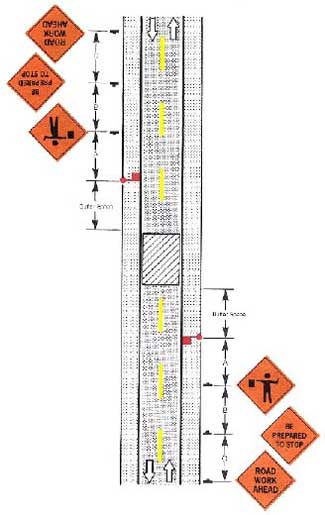
|
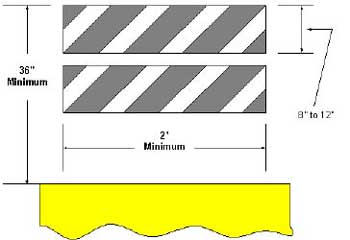
|
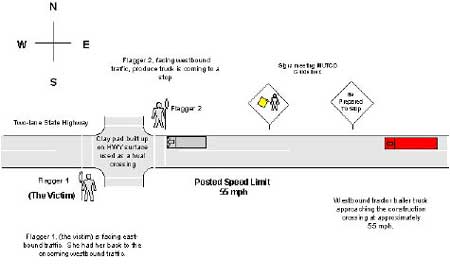
|
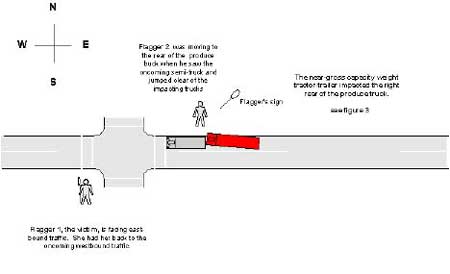
|
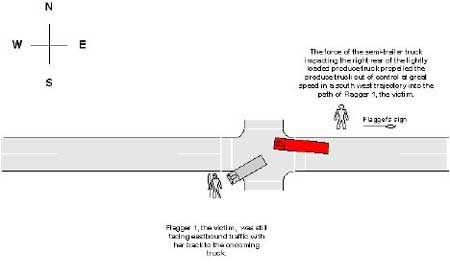
|
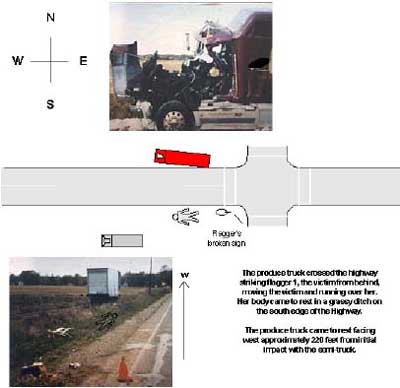
|
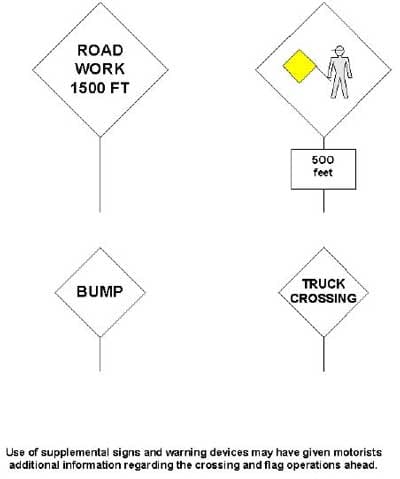
|
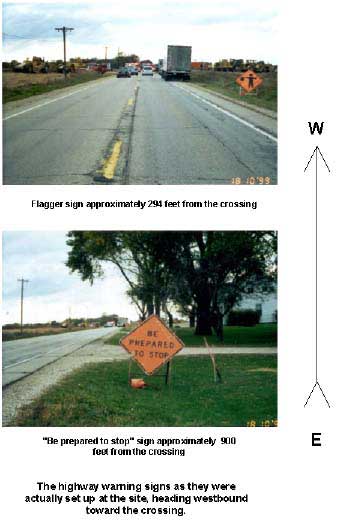
|
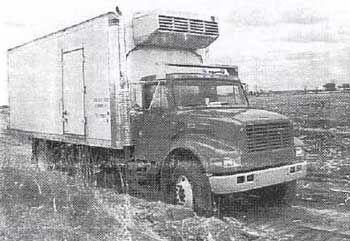
|
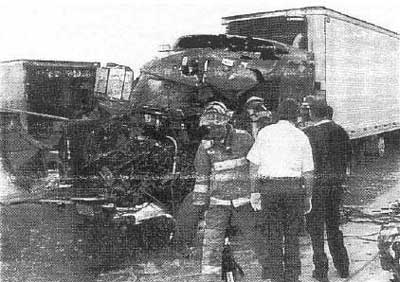
|
|
Photo 3. Semi-Tractor Trailer Truck Loaded, Approximately 22 Tons
|
